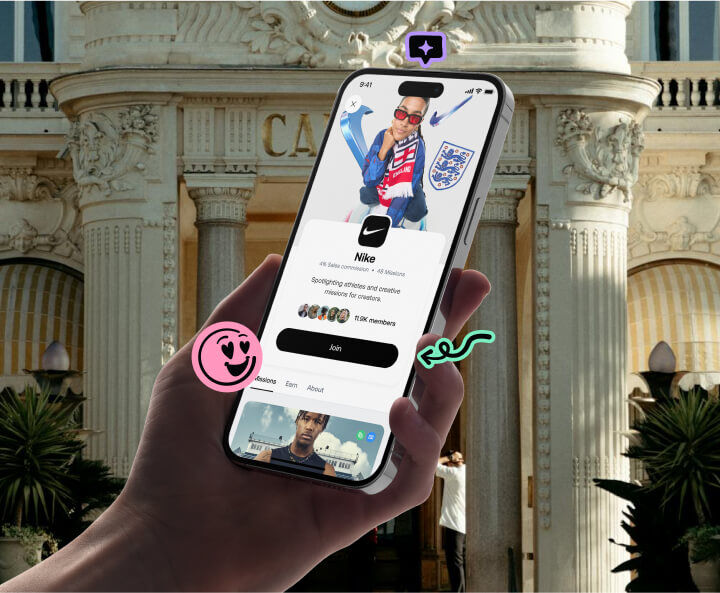Why community marketing is your last defense against digital collapse and rising CAC
 Why community marketing is your last defense against digital collapse and rising CAC">
Why community marketing is your last defense against digital collapse and rising CAC">

What you will learn
- Why relying on third-party data and paid ads guarantees unsustainable customer acquisition costs (CAC).
- The financial imperative of maximising customer lifetime value (LTV) through community retention.
- How leading global brands like Celsius and Samsung are using Club to scale authentic, sales-driving user-generated content (UGC) and penetrate niche markets.
- The three strategic pillars required to build brand resilience in 2026.

In summary: The 2026 community mandate
Trust collapse
Only 39% of consumers trust advertising in general, forcing a dependence on peer-to-peer validation aka community.
Data scarcity
The deprecation of third-party cookies makes owned, first-party data, sourced from your community, mandatory for personalisation and attribution.
CLG is profit
Community-led growth is fundamentally a retention strategy, where a mere 5% increase in retention can boost profits by up to 95%, according to Bain.
Mobilise your fans
Platforms like Club are used by brands to automate community engagement, turning loyal customers into sales-driving brand advocates who generate highly trusted content.
The cost of inaction
Brands that delay this pivot risk high churn rates and financial failure in a fiercely competitive, trust-based market.
The looming crisis: Why traditional B2C marketing dies in 2026
The consensus across the marketing landscape is clear: the foundational strategies that drove B2C growth over the last decade are rapidly becoming liabilities.
For brands relying heavily on paid media and third-party data, 2026 represents an existential deadline. The efficiency of traditional advertising models is collapsing under the weight of consumer skepticism, regulatory shifts, and structural increases in acquisition costs.
Businesses that fail to acknowledge this tectonic shift and pivot to a consumer-centric, community-first model risk immediate marginalisation and eventual failure.
1. The trust deficit: Analysing the collapse of ad credibility
Consumer trust has transitioned from being a subjective soft metric to the primary conversion barrier. Data from The Advertising Association indicates a critical failure in traditional advertising effectiveness: only 39% of consumers trust advertising in general.
This low level of confidence stands in sharp contrast to the consumer requirement for purchase, where 88% of all buying decisions are influenced by trust.
The underlying implication of this data is profound: $5 billion in ad spend was wasted in 2022 because it failed to further commercial objectives.
Continuing to scale paid campaigns without solving this trust deficit guarantees a perpetually high floor on customer acquisition costs (CAC). Furthermore, consumers actively signal their distaste for disruptive paid formats, with 73% disliking pop-up ads.
When consumers do seek credible information, they bypass brand broadcasts entirely. They rank creators, individuals who have cultivated authentic communities, as the number one trusted source over both social media ads and celebrities.
The causal link is undeniable: high-paid spend generates low perceived trust, leading to an inability to influence purchases, ultimately ensuring diminishing ROI. The only scalable, authentic source of trust capable of mitigating this risk is peer-to-peer validation, inherently found in a brand community.
2. The great data reckoning: Third-party cookie deprecation and the $0 value proposition
The structural collapse of traditional digital advertising is accelerated by the phasing out of third-party cookies. This is more than a technical adjustment; it represents the demise of the core attribution and personalisation engine that modern B2C marketers rely upon.
Measures like Firefox’s Enhanced Tracking Prevention (ETP) already restrict cross-site tracking, making retargeting based on users’ browsing history extremely difficult and potentially impacting the accuracy of analytics data.
The commercial consequences are severe. Early reports on Google’s Privacy Sandbox indicate that publishers could lose an average of 60% of their revenue. As the ability to precisely track and retarget audiences evaporates post-2026, the cost of reaching the right consumer through opaque ad channels will skyrocket.
Despite this data fragmentation, the consumer expectation for relevance remains high, with 71% expecting companies to deliver personalised experiences.
When third-party data vanishes, satisfying this expectation through inefficient paid means becomes prohibitively expensive, leading to bloated CAC and organisational frustration. The strategic solution is to pivot sharply toward first-party data capture.
An owned brand community, by definition, becomes a reliable, proprietary source of first-party data, transforming engaged customers into data generators and securing a brand’s ability to personalise marketing ethically.
3. The ROI illusion: Escalating CAC vs. diminishing returns
The financial trap facing the B2C sector is the simultaneous growth of marketing budgets and the decline of paid channel efficacy. While overall marketing budgets are growing cautiously (3.3% in 2025), driven primarily by increased digital spending (up 7.3%), the efficiency of that spend is actively eroding.
While conventional theory suggests 4:1 return on ad spend (ROAS) is “good,” current data shows that most industries come in well below this threshold.
Brands are caught in a feedback loop: they spend more on channels that return less, directly squeezing their margins. This financial pressure is starkly visible in sector data: the wellness sector averages a 1.45% ROAS (return on ad spend) on Facebook, and beauty sits at 1.57%. Both fall well below the industry median of 2.19%.
This unsustainable paid model stands in stark contrast to the colossal returns generated by organic channels: SEO boasts an average ROAS of 9.4%, meaning brands generate $9.4 in revenue for every $1 spent on SEO with an average ROI of 825%.
The average ROI for email marketing ranges from $36 to $40 for every dollar spent. The data demonstrates that continuing to chase traffic through high-cost, low-trust paid channels is financially irresponsible; the future of profitability belongs to strategies that inherently fuel high-ROI organic growth vectors, placing community at the epicentre.
The new centre of gravity: putting the consumer (and community) at the heart
Survival in the 2026 landscape demands a foundational pivot from a transactional, product-out marketing approach to a relational, customer-in model. This pivot defines the brand as a convener of shared interests, not just a seller of goods.
1. The expectation economy: Authenticity and participation
Today's consumer expects radical transparency and authenticity. They view brand purpose as a non-negotiable factor, with 72% willing to pay more for products from brands that demonstrate a commitment to social and environmental causes.
Furthermore, consumers expect brands to facilitate dialogue and participate authentically. Nearly half (48%) of consumers strongly agree that they read social media comments to understand what others are saying about a brand.
When a brand ignores or attempts to silence customer dialogue, for instance, by disabling comments on social media posts, it risks creating a perception of evasiveness and actively undermining earned trust. This action directly contradicts the high trust required for a purchase decision. To succeed, brands must integrate the customer voice into every facet of the business. Community provides the necessary structured dialogue, allowing brands to gather iterative insights and demonstrate accountability, thus meeting the consumer’s demand for authenticity and highly personalised experiences.
2. From transactional to relational: Defining the community-led growth (CLG) model
The traditional B2C model, focused narrowly on direct selling, is being supplanted by community-led growth (CLG). Community-based models thrive on user participation, often centered around specific interests, hobbies, identity, or lifestyle.
This approach transcends a basic e-commerce relationship, creating deep, meaningful connections that generate social proof and organic referral marketing. This pivot is enabled by dedicated CLG platforms like Club, which transform engaged customers into enthusiastic brand advocates and sales-driving content creators by harnessing word-of-mouth marketing.
CLG deliberately leverages "trust capital", the accumulated credibility resulting from authentic peer interactions. This is a critical strategic distinction: while paid marketing rents attention, CLG builds influence and loyalty.
This shift is validated by data showing that all generations across numerous participants ranked creators (peers within an ecosystem) as the number one trusted source, demonstrating the inherent influence embedded in peer-to-peer relationships. By channeling resources into nurturing this community, brands offset the high acquisition costs of paid channels by activating existing customers as trusted agents of referral and validation.
3. The strategic value of owned data: How community infrastructure secures first-party insights
The post-cookie world mandates a pivot to owned data infrastructure. Community provides the essential architecture for this transition. An active brand community offers a reliable source of proprietary first-party data and grants access to iterative customer insights and feedback with improved data quality.
A dedicated customer data platform (CDP) becomes crucial for effectively collecting, storing, and segmenting this owned data, enabling brands to deliver the personalised marketing campaigns expected by consumers without relying on outdated tracking methods or breaching privacy boundaries.
By creating this proprietary, protected data ecosystem, the brand turns a regulatory headwind (GDPR, CCPA, cookie phase-out) into a competitive advantage. This strategic investment shifts the cost of data acquisition from opaque, expensive tracking to a value-based exchange: the brand provides the community, loyalty perks, and early access in return for explicit behavioural data and loyalty.
The financial mandate: quantifying community ROI in LTV and CAC
The investment in community is often wrongly perceived as a soft metric. However, community-led growth is fundamentally a financial strategy designed to maximise the customer lifetime value (LTV) and sustainably drive down the customer acquisition cost (CAC), optimising the crucial LTV/CAC ratio.
1. The golden ratio: Targeting an ideal LTV/CAC for sustainable B2C growth
The LTV/CAC ratio measures the return on sales and marketing spend. For high-growth companies, the ideal ratio is often cited as 3:1. Community marketing strategically impacts both sides of this equation: it lowers the CAC by relying on organic, referral-based growth, and it simultaneously raises the LTV through enhanced retention and increased customer spending.
This analytical framework exposes the financial leverage of retention. It costs a brand 5–7 times more to acquire a new customer than it does to retain an existing one. Consequently, short-term thinking, which typically prioritises immediate conversion metrics, actively sacrifices the vast long-term profit potential locked within retention strategies.
2. Retention as the profit engine: How community engagement drives exponential profit increase
The profit impact of retention is exponential, not linear. Research shows that a mere 5% improvement in customer retention can increase business profits by up to 75%. This single metric underscores the economic mandate for community investment. When customers feel they belong to a community, loyalty rates rise significantly; roughly 60% of customers report staying loyal to a brand under these conditions.
Furthermore, empirical research analysing social media brand communities confirms that engagement leads to a positive increase in individual consumer purchase expenditures. This means that community not only makes customers stay longer (increasing the "L" in LTV) but also encourages them to spend more during their tenure.
Traditional marketing teams, preoccupied with immediate quarterly metrics, often underinvest in brand equity and the long-term customer relationships that yield this 75% profit increase potential. Community investment represents a decisive commitment to maximising the most potent engine of sustainable profit: customer loyalty.
3. The economic impact of user-generated content (UGC): Trading ad spend for trust capital
The strategic pivot to community recognises that the most powerful marketing message in 2026 comes from customers, not the company. Fostering user-generated content (UGC) is the new digital word-of-mouth and the ultimate trust signal.
Platforms like Club specialise in formalising this process, allowing brands to create, schedule, and automate engaging Missions for community members. These Missions mobilise the community to generate authentic content and drive direct sales.
For instance, brands can prompt members to share social posts that meet specific criteria, or leverage Club's affiliate discount code engine, and tracking links to convert advocacy directly into measurable revenue.
Quantitative analysis of brand communities demonstrates that UGC, particularly through undirected communication among peers, has a significant positive elasticity of demand. Conversely, marketer-generated content (MGC) frequently shows an insignificant impact on purchasing behaviour, confirming the public's distrust of brand messaging.
The implication is that the brand’s community strategy should prioritise facilitation over broadcasting. Investment in community infrastructure and management generates content and feedback that substantially reduces internal content creation costs and keeps the brand ecosystem dynamic. This approach swaps high-cost, low-trust ad spending for high-trust, high-impact peer endorsement, fundamentally optimising the cost structure of acquisition.

Quantitative analysis of brand communities demonstrates that UGC has a significant positive elasticity of demand.
The table below summarises the critical financial advantages of shifting focus from high-CAC paid channels to high-LTV community strategies:
Community-led growth vs. traditional acquisition: The LTV/CAC imperative
|
Strategy focus |
Impact on LTV/CAC ratio |
Quantified financial impact |
|
Customer retention |
Increases LTV; lowers denominator (cost to retain vs. acquire). |
5% retention increase yields up to 75% profit increase. |
|
Organic/SEO channels |
Increases LTV; extremely low CAC once established. |
SEO provides 825% average ROI (3-year average). |
|
Community engagement |
Increases LTV (higher repeat purchase expenditures). |
Leads to a positive increase in individual consumer purchase expenditures. |
|
Traditional paid ads |
Lowers LTV, inflates CAC. |
ROI decline. |

Blueprints for resilience: Brands winning with Club.co
Elite B2C brands are using dedicated CLG technology like the Club platform to standardise and scale their community efforts. The platform is specifically designed to transform customers, fans, and followers into a loyal community that generates sales and brand awareness.
These brands leverage Club's Missions feature to mobilise their communities, assigning customizable tasks and challenges in exchange for rewards. This effectively turns the community into a scalable, on-demand content and sales engine.
Case example: Celsius
Scaling global trust and UGC.
The energy drink brand Celsius demonstrates a successful global CLG model built on consumer trust, an essential component for any successful B2C brand. Recognising the predictive power of strong brand equity, Celsius leverages its community through the Club platform to cultivate authentic engagement.
Instead of relying solely on costly, low-trust advertising, Celsius uses the platform’s Missions feature to mobilise fans into a powerful UGC engine. This approach ensures that content used to boost brand awareness and drive sales is generated by genuine advocates, strengthening credibility and allowing the brand to scale its authentic community-led strategy globally.
Case example: Samsung
Niche mobilisation and fan experience.
Samsung, a global technology leader, uses the Club platform to execute precise, hyper-targeted campaigns by building communities within niche customer segments. For example, during seasonal periods like the Back to School rush, Samsung leverages its brand fans to generate high-trust content. By deploying Missions through the platform, Samsung can incentivise specific groups (like students or parents) to share their authentic product experiences and device usage in a niche context. This strategy moves beyond mass-market advertising, effectively utilising highly engaged fans to create influential peer-to-peer marketing that resonates with specific, high-value consumer groups and bolsters the campaign's awareness and impact.
Case example: Cocunat
The brand successfully activated its ambassador network via Club to generate buzz and boost engagement surrounding a key store opening, demonstrating the platform’s power in driving offline, real-world commercial results through digital community mobilisation.
As the Influencer Marketing Lead for NAKD noted, Club is "an amazing tool" for activating large numbers of influencers monthly or for specific campaigns. This shift from expensive, broad-reach campaigns to targeted community activation via owned platforms like Club is the strategic foundation for competitive resilience in 2026.

The cost of silence: Why delaying community investment guarantees failure
The brand that chooses inaction in the face of the 2026 market shifts is choosing a high-risk liability strategy. Delaying community investment amounts to an outright guarantee of struggle and failure.
1. The erosion of trust: The penalty for ignoring customer dialogue
The margin for error in customer experience has shrunk dramatically. B2C brands are under intense pressure to deliver exceptional experiences, yet the tolerance for mistakes is virtually zero: 70% of consumers report they will abandon a brand after just two negative experiences, and almost a quarter will stop purchasing after only one bad experience.
When brands ignore the opportunity for dialogue, they actively compound this risk. Consumers expect transparency and seek accountability by reading social media comments to understand others’ experiences.
When a brand fails to engage or, worse, disables the mechanism for open dialogue, it creates a perception of evasion and actively destroys earned trust, which directly impacts the sales funnel. Community management is thus transformed from a soft marketing function into a mission-critical risk management strategy.
It provides the necessary early warning system to capture and resolve negative experiences privately before they spiral publicly, thereby safeguarding long-term customer value. Ignoring this mechanism ensures higher churn rates and substantial financial difficulty.
2. The trap of short-term thinking: Sacrificing lifetime value for quick wins
The most significant threat to brand resilience is organisational shortsightedness. Focusing solely on short-term ROI, such as immediate cost reduction or quarterly profits, inevitably leads to the systematic cutting of critical long-term investments like brand equity, research and development, and customer experience.
This "efficiency myopia" is financially destructive in a market where CAC is structurally rising. A cautionary example is the use of rigid, self-service AI implemented solely to deflect customers and reduce human agent headcount for short-term savings. While this looks appealing on a balance sheet, it degrades service quality, frustrates customers, and risks losing customers "for life".
The true cost of saving a few cents today is the forfeiture of the customer’s entire lifetime value. Leaders who fail to recognise the long-term financial payoff of a strong brand—which attracts customers at a lower CAC, who pay more and buy more often—are making financially illiterate decisions that guarantee difficulty in achieving long-term profitable growth.
3. Failure points: Common reasons B2C community initiatives fall short
Community initiatives rarely fail due to external customer apathy; they almost always fail because of internal, organisational execution deficits.
The foremost challenge is a lack of strategic alignment. A community is unlikely to succeed if it is not given executive buy-in and treated as a strategic initiative rather than a tactical marketing channel. If leadership teams do not understand the value proposition, the initiative will inevitably be starved of resources.
Even once launched, a community is like an "infant child" that requires sustained nourishment and attention to gain traction; impulsively launching without a long-term plan or dedicated management often leads to the loss of investment and a perceived failure to deliver value.
Organisational obstacles, technology implementation failures, and critical skill gaps, including scaling, burnout management, and conflict resolution, remain constant hurdles. Viewing community investment as optional rather than mandatory infrastructure ensures that the brand remains defenseless against the rising pressures of the 2026 digital marketplace.

The 2026 community marketing roadmap: A strategic action plan
To establish resilience and capture competitive advantage by 2026, B2C consumer brands must execute a decisive shift across three core pillars: Infrastructure, Content Strategy, and Trust Scaling.
Pillar 1: Infrastructure and ownership
The primary mandate is to transition customer data ownership from rented third-party platforms to proprietary, owned infrastructure. This requires the immediate implementation of a customer data platform (CDP) integrated with an owned brand community platform, such as Club.
This strategic investment secures the proprietary first-party data necessary to deliver the personalised experiences that 71% of consumers demand, future-proofing the business against the ongoing collapse of third-party tracking.
The executive team must shift key performance indicators (KPIs) away from vanity metrics and immediate conversions toward metrics that prioritise long-term growth, primarily focusing on maximising Customer lifetime value (LTV) and market strength.
Pillar 2: Content strategy evolution (SEO and AI)
Content strategy must evolve beyond generic, high-volume keywords to focus on depth and conversational intent, capitalising on the 825% average ROI of SEO. Brands must adopt an answer engine optimisation (AEO) approach, optimising content to gain visibility in generative AI tools (like ChatGPT and Gemini) and prioritise deep, comprehensive content that directly answers specific user questions.
Community dialogue is an invaluable asset in this transition, as active discussions reveal the precise, high-intent, low-volume keywords that drive conversion. By catering content to these long-tail queries, the brand ensures its investment directly addresses customer needs and captures high-converting traffic.
Pillar 3: The ambassador strategy
Brands must systematically replace expensive, low-trust advertising with authentic, scalable peer-to-peer relationships. This means formalising brand ambassador programs. Platforms like Club streamline the recruitment, organisation, and ongoing management of these ambassador and affiliate programs.
The focus should be on recruiting passionate, local community members, micro- and nano-influencers who possess highly engaged, though smaller, audiences. These individuals should be rewarded with recognition, connectivity, and product benefits, rather than large cash payments.19
This strategy formalises the peer recommendation volume (as seen with industry leaders’ 70-80% referral rate), effectively outsourcing the acquisition engine to the brand’s most trusted promoters and simultaneously scaling authentic trust at a fraction of the cost of mass media acquisition.

The 2026 strategic blueprint: Community pillars for B2C resilience
|
Strategic pillar |
2026 mandate |
Key business outcome |
|
Data ownership |
Implement first-party data capture via owned community platforms. |
Future-proofs personalisation against third-party cookie collapse. |
|
LTV prioritisation |
Align investments to optimise LTV/CAC (prioritising retention). |
Increases profit margins up to 75% by focusing on existing customers. |
|
Content strategy |
Shift to Answer Engine Optimisation (AEO) and conversational SEO. |
Captures high-intent search traffic and ensures visibility in AI search results. |
|
Trust scaling |
Formalise community ambassador programs using platforms like Club. |
Replaces distrusted paid ads with organic peer-to-peer recommendation volume. |

Conclusion
The marketing landscape is not merely changing; it is fundamentally restructuring. The confluence of eroding consumer trust, the final collapse of third-party data, and the unsustainable upward trajectory of CAC has rendered legacy, paid-media-centric strategies obsolete.
By 2026, consumer brands must treat community marketing not as an optional engagement tactic, but as the essential infrastructure for securing trust, maximising LTV, and ensuring financial survival.
The evidence is conclusive: brands who choose short-term efficiency over long-term brand equity, who continue to prioritise immediate conversions over cultivating relationships, and who fail to secure their first-party data assets will struggle to maintain margin, experience high churn, and face inevitable failure. The pathway to resilience is clear: place the customer and their community at the heart of the business - today.

Keep up with the
latest from Club

Get more inspiration
%20copy.png)
Why you need to start building your brand community in-house.

.webp)
10 proven activation methods to power your ambassador marketing


 Book a demo
Book a demo


